Did you know sharks are older than trees? Sharks first appeared almost 400 million years ago and have been extraordinarily resilient, having survived all five global mass extinctions, including the Permian-Triassic extinction that wiped out 95% of all life on Earth.
Today, more than 500 species of shark swim throughout the world’s salt and fresh waters, each with its own unique characteristics and adaptations.
The 8 types of sharks
Sharks come in a wide range of shapes and sizes, and biologists have classified them into several different orders based on their physical characteristics and evolutionary relationships. The eight orders of sharks are as follows:
- Heterodontiformes: This small order includes just a few species of sharks, such as the horn shark and the Port Jackson shark. These sharks are characterized by their distinctive teeth, which are adapted for grinding and crushing rather than tearing prey apart like some other shark species.
- Orectolobiformes: This order includes the carpet sharks, which are characterized by their distinctive patterns and the presence of barbels around their mouths. Examples of carpet sharks include the nurse shark and the wobbegong.
- Carcharhiniformes: This is the largest order of sharks, and it includes a wide variety of species, such as the tiger shark and the bull shark. These sharks are characterized by their triangular teeth and streamlined bodies, which allow them to move through the water with ease.
- Lamniformes: This order includes mackerel sharks, which are known for their large size and high metabolism. Examples of mackerel sharks include the great white shark and the mako shark.
- Squaliformes: This order includes the dogfish sharks, which are small, bottom-dwelling sharks. Other examples of squaliformes include the spiny dogfish and the Greenland shark, characterized by their flat bodies and wing-like pectoral fins.
- Squatiniformes: This small order includes just a few species of angel sharks, which are characterized by their flat bodies and wing-like pectoral fins.
- Pristiformes: This order includes the sawsharks, which are characterized by their long, saw-like snouts and toothed rostra.
- Hexanchiformes: This small order includes just a few species of cow sharks, which are characterized by their long, narrow bodies and six-gill slits.
| Order | Defining Characteristics | Example Species | Geographical Range |
|---|---|---|---|
| Heterodontiformes | Small size, distinctive teeth adapted for grinding and crushing | Horn shark, Port Jackson shark | Coastal waters in the Eastern Pacific, Western Atlantic, and Indian Oceans |
| Orectolobiformes | Distinctive patterns, barbels around mouth | Nurse shark, wobbegong | Worldwide, but most diverse in the Indo-West Pacific |
| Carcharhiniformes | Triangular teeth, streamlined bodies | Tiger shark, bull shark | Worldwide, with many species found in tropical and subtropical waters |
| Lamniformes | Large size, high metabolism | Great white shark, mako shark | Worldwide, with many species found in temperate and tropical waters |
| Squaliformes | Small size, bottom-dwelling | Spiny dogfish, Greenland shark | Worldwide, with many species found in cold, deep waters |
| Squatiniformes | Flat bodies, wing-like pectoral fins | Angel sharks | Coastal waters in the Eastern Pacific, Western Atlantic, and Indo-West Pacific |
| Pristiformes | Long, saw-like snouts, toothed rostra | Sawsharks | Coastal waters in the Eastern Pacific, Western Atlantic, and Indo-West Pacific |
| Hexanchiformes | Long, narrow bodies, six-gill slits | Cow sharks | Worldwide, but most diverse in deep, cold waters |
The most iconic types of sharks
Below is a list of some of the most common and memorable types of sharks.
Whale Shark (Rhincodon typus)
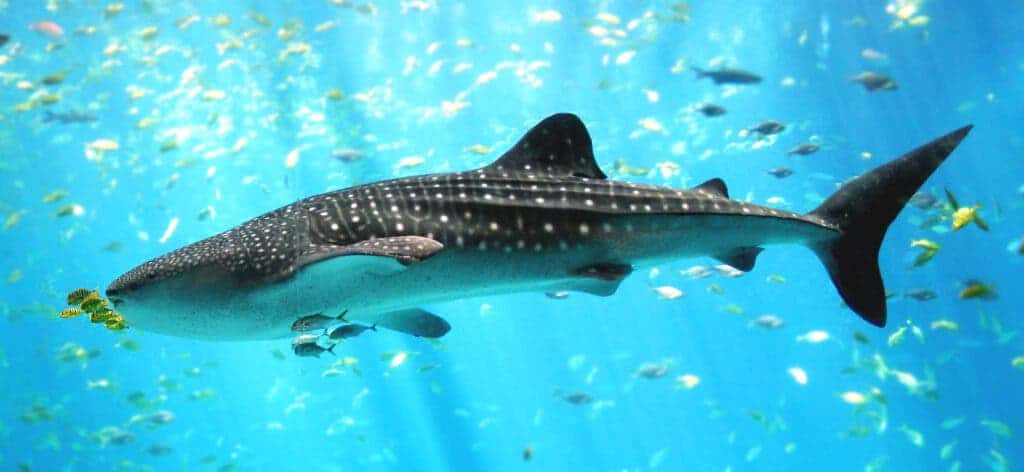
Sharks are cartilaginous fish and the huge whale shark is not only the largest shark but also the largest fish in the world. They certainly stand out from all other types of sharks.
The slow-moving whale shark is an awe-inspiring sight to behold, measuring up to 12.6 meters (41.5 feet) in length and weighing 20 tons. That’s about the size of a school bus.
That may sound frightening, but the good news is whale sharks aren’t predators and are no threat to humans. In fact, they are often curious and will approach divers and snorkelers, allowing them to get close enough to touch or even hitch a ride.
The whale shark is a filter-feeding shark, whose diet consists of krill, fish eggs, crab larvae, and only occasionally any small fish or octopus that gets caught in its 1.5-meter (4.9-foot) wide mouth. According to researchers at the Atmosphere and Ocean Research Institute, whale sharks can survive for weeks without food. During such starvation periods, they may ingest seaweed and other plants.
Whale sharks are found in tropical and warm temperate waters around the world, and they are most commonly seen in the Indian Ocean and the western Pacific Ocean. They are known to migrate over long distances, and they have been tracked moving between the Philippines, Indonesia, and Australia.
The species is classified as endangered by the International Union for the Conservation of Nature (IUCN). Their numbers and habitat have decreased dramatically over the last decades, primarily due to human activity like offshore drilling and fishing.
Angelshark (Squatina)
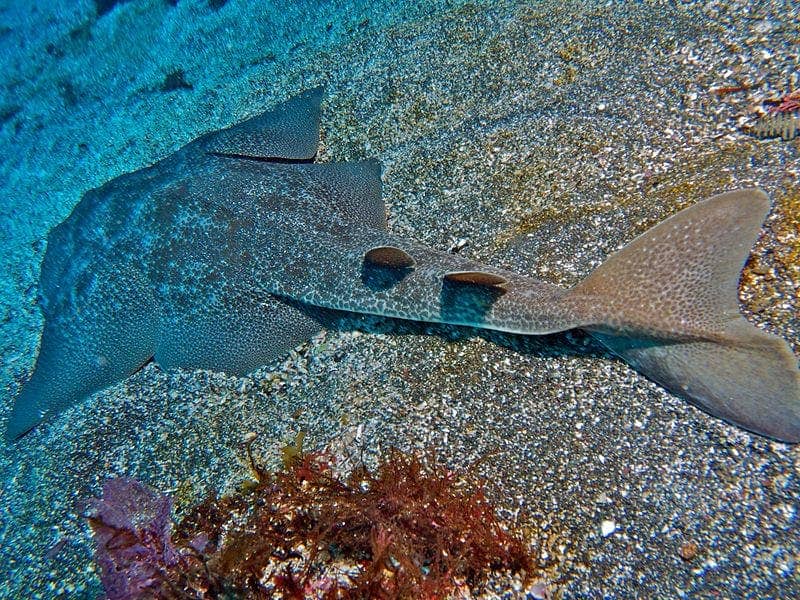
Angelsharks were once one of the most abundant types of shark swimming in the coastal waters of Western Europe and Northern Africa. They have flattened bodies and wide pectoral fins, which make them look similar to rays.
Although they can be found all over the world, nowadays angelsharks remain most abundant in the western and eastern sides of the Atlantic and Pacific oceans, respectively. They often like to linger buried in the sand on the very bottom of the ocean with just their eyes and nostrils exposed. They can stay in this position for days at a time, waiting for their favorite prey — typically fish, crustaceans, or mollusks.
They are well-camouflaged with a pattern of brown, black, and white markings that help them blend in with the sandy bottom of their habitat. They use their sense of smell and their highly sensitive lateral lines to detect the presence of prey, which they ambush with a sudden burst of speed.
Humans have long known about them, with angelsharks mentioned in ancient writings by such authors as Aristotle, Mnesitheus, Diphilus, and Pliny the Elder, who considered the angelshark’s meat as an important food source and its skin as a useful material for polishing ivory and wood.
Unfortunately, overfishing has driven the angelshark close to extinction, with populations estimated to have declined by up to 90% in the past 45 years. The IUCN lists the angelshark as critically endangered.
But there are also reasons to be optimistic. Angelshark fishing has been illegal in the Mediterranean Sea since 2011 and in all coastal waters of any EU member country since 2010.
Shortfin Mako Shark (Isurus oxyrinchus)
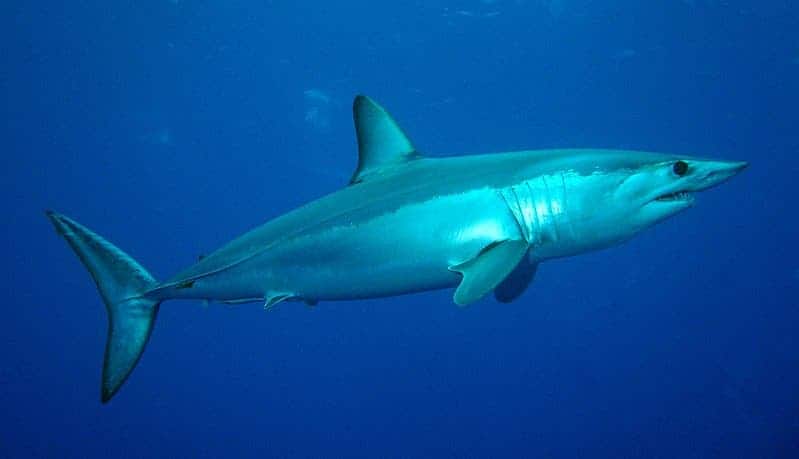
The Shortfin Mako is thought to be the fastest of all sharks, having been recorded swimming up to 75 km/h (45 mph).
These sharks have very pointed snouts and long gill slits. They grow slowly but can reach up to 13 feet long (4 meters) and live to be over 30 years old.
They have a streamlined, hydrodynamic body that is built for pursuit and attack. The shark’s eyes are large and positioned on the sides of its head, giving it excellent vision and the ability to detect movement from all angles. It can also make sudden, dramatic changes in direction and has been known to breach the surface of the water when attacking prey or displaying to other sharks.
Shortfin makos are very aggressive predators that feed near the top of the food chain on large marine fishes such as swordfish, tuna, marine mammals, and even other sharks. They’ve also been blamed for some reported shark attacks on humans, though most involved fishermen who dragged hooked makos into their boats.
Prior to their attack, makos swim in figure-eight patterns and approach their prey with their mouths open.
Makos are highly migratory and can travel across entire oceans, although they prefer waters off the coast of New England and the Mid-Atlantic. Despite its fearsome reputation, due to overfishing, stocks of mako sharks have been dramatically depleted, compelling the World Conservation Union to list them as “Near Threatened”.
Hammerhead Shark (Sphyrnidae)

The hammerhead sharks are a group of sharks that form the family Sphyrnidae. They’re among the most recognizable types of sharks in the world due to the distinctive hammer-shaped structures of their heads.
Although they might look dweeby, hammerheads are actually fierce predators that live in warm tropical waters and feast on a wide variety of marine creatures. The hammerheads use their wide heads to trap stingrays by pinning them to the seafloor. The peculiar eye placement, on each end of its very wide head, allows the hammerhead shark to scan a larger area more quickly than other sharks are able to. Sensors on the head can pick up on the electric fields generated by other animals.
Unlike most other fish, female hammerheads don’t lay eggs. Instead, they give birth to live young, up to 50 pups at a time. When they’re babies, though, the hammerheads have more rounded heads than their parents.
There are nine known species of hammerhead sharks, which are found in tropical and warm temperate waters around the world. They range in size from the small bonnethead shark (Sphyrna tiburo), which grows to just 1.5 meters (5 feet) in length, to the giant hammerhead (Sphyrna mokarran), which can reach up to 6 meters (20 feet) in length.
In addition to their hunting abilities, hammerhead sharks are also known for their social behavior. Some species, such as the scalloped hammerhead (Sphyrna lewini), form large groups and have been observed exhibiting complex social behaviors, including cooperation and communication.
They’re not aggressive towards humans, although a few attacks have been reported throughout history.
Zebra Shark (Stegostoma fasciatum)
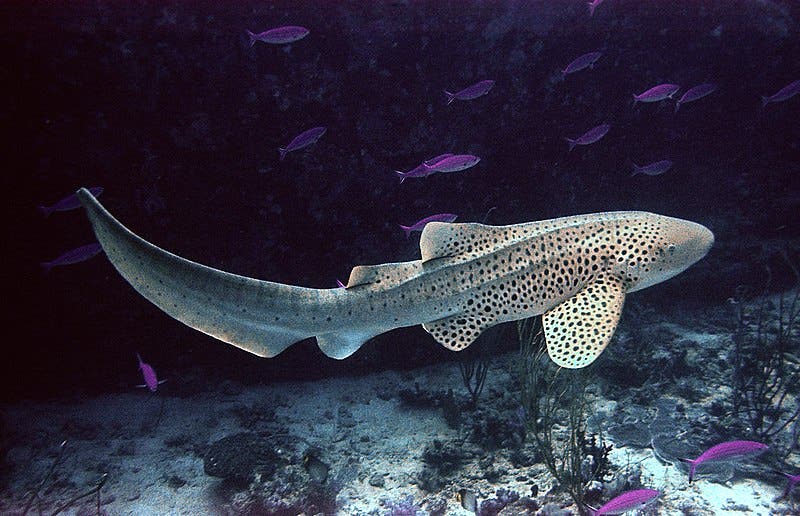
The zebra shark is a species of carpet shark and the sole member of the family Stegostomatidae. They are very large sharks that live in the shallow coral reef habitats in tropical waters of the Western Pacific and Indian Oceans.
The sharks owe their name to the distinct yellowish stripes that cover their brown bodies when they’re young. When they reach adulthood, the zebras shed their stripes for small brown or grey dots, resembling leopard sharks.
The zebra shark is a large species, growing up to 3 meters (10 feet) in length and weighing up to 150 kilograms (330 pounds). It has a long, slender body with a wide, flattened head and a long, pointed snout. It is well-adapted to life on the ocean floor, with a streamlined body and powerful pectoral fins that allow it to swim with ease.
Zebras are nocturnal foragers and solitary creatures that hunt small fish, snails, sea urchins, and crabs. Despite their large size, zebras are totally harmless to humans. In fact, they adapt well to captivity, making them a common attraction at many aquariums around the world.
Unfortunately for the zebras, many find their fins delicious, which are sold fresh or salt-dried in markets throughout Indonesia, Thailand, Malaysia, Philippines, and elsewhere. Due to overfishing, zebras are considered endangered by the IUCN Red List
Basking Shark (Cetorhinus maximus)
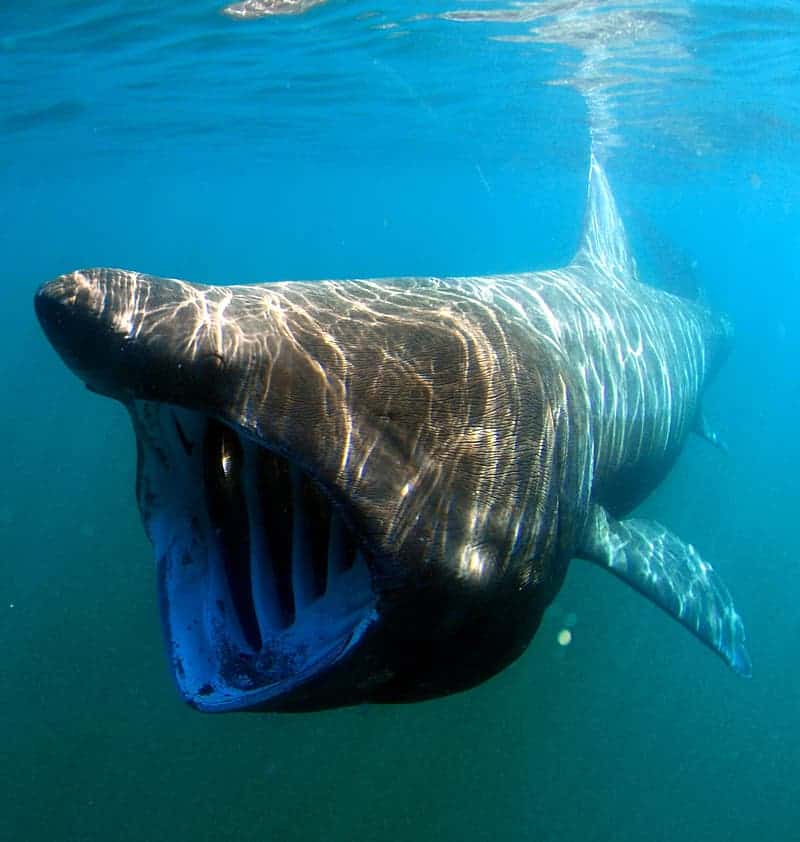
As one of the most awe-inspiring fish and the second-largest shark species, basking sharks are easily recognizable by their long gill slits which almost encircle the head and their pointed snout. Its skin is smooth and grey, and is covered in tiny scales called dermal denticles, which give it a sandpaper-like texture.
These sharks are simply massive. Some grow as large as 12 meters (40 feet) and can weigh 7 tons. Due to their intimidating, almost predatory appearance, many people are frightened by them. However, basking sharks are quite harmless, spending most of their time with their oversized mouths open, filtering out their favorite prey — plankton.
An adult basking shark swimming at a constant speed of two knots passes about 2,000 gallons of water over its gills per hour! An individual shark may have as much as a half-ton of food in its stomach.
Basking sharks are one of the few species that live in temperate latitudes, both north and south of the equator, and are known to migrate long distances in search of food. They’re also very social animals, most often being spotted in groups of 2 or 3 individuals, and sometimes up to very large groups of 500 or more.
Bull Shark (Carcharhinus leucas)
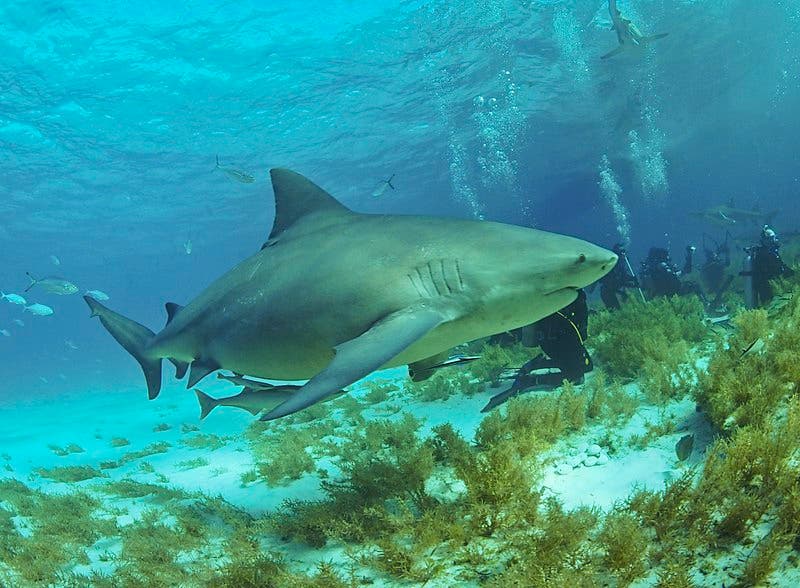
Most people are most frightened by great whites, but if there’s one shark you should stay clear of, that’s the bull shark. This is a highly aggressive type of shark, which tends to hunt prey in tropical water around coasts frequented by humans.
Bull sharks get their name from their short, blunt snout, as well as their highly quarrelful tendencies. Often, these sharks will head-butt their prey before approaching for an attack, exactly like a bull would.
These are common sharks found in warm, shallow waters across the world’s oceans. It grows up to 3.5 meters (11.5 feet) in length and can weigh up to 230 kilograms (500 pounds).
One of the most unique characteristics of the bull shark is its ability to tolerate both salt and fresh water. It is one of the few species of shark that can swim up rivers and has been found as far as 1,500 kilometers (932 miles) up the Amazon River in South America.
Fast and agile, these predators will eat almost anything they pick up on their radar, including fish, dolphins, and other sharks. No humans, though, although there have been reported attacks — mostly inadvertent attacks when the shark threatened or provoked.
Nurse Shark (Ginglymostoma cirratum)
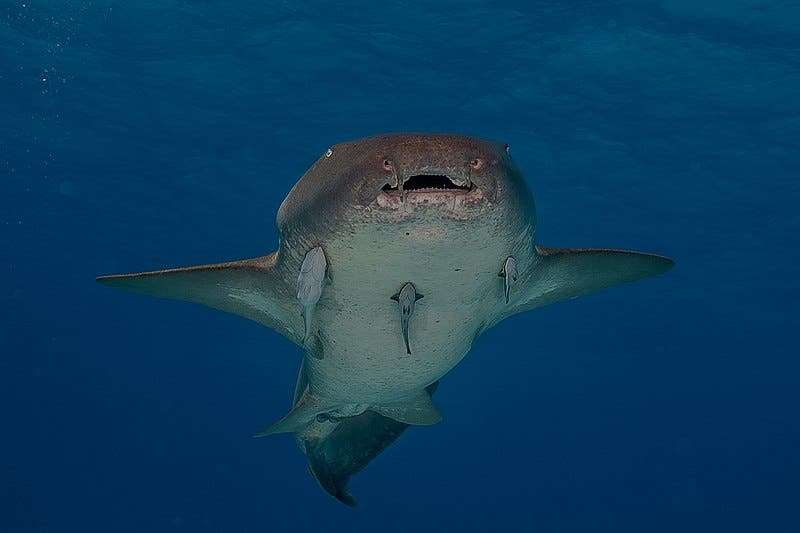
These are perhaps the most sluggish and sedentary of all types of sharks. These couch potatoes of the shark world rest by day, preferring to slowly creep over the sandy ocean floors during the night, slurping up little animals in the shallow, coastal waters.
As a fun fact, the slow-moving predators sometimes use their pectoral fins to “walk” across the bottom of the oceans. They also have fleshy sense organs on their faces, known as barbels, which they drag across the sand in search of prey — fish, shrimp, and squid.
The nurse shark gets its name from its habit of “nursing” or resting motionless on the ocean floor, often in groups. It grows up to 3.7 meters (12 feet) in length and can weigh up to 200 kilograms (440 pounds).
Nurse sharks are abundant throughout their range in the warm, shallow waters of the western Atlantic and eastern Pacific oceans.
Tiger Shark (Galeocerdo cuvier)
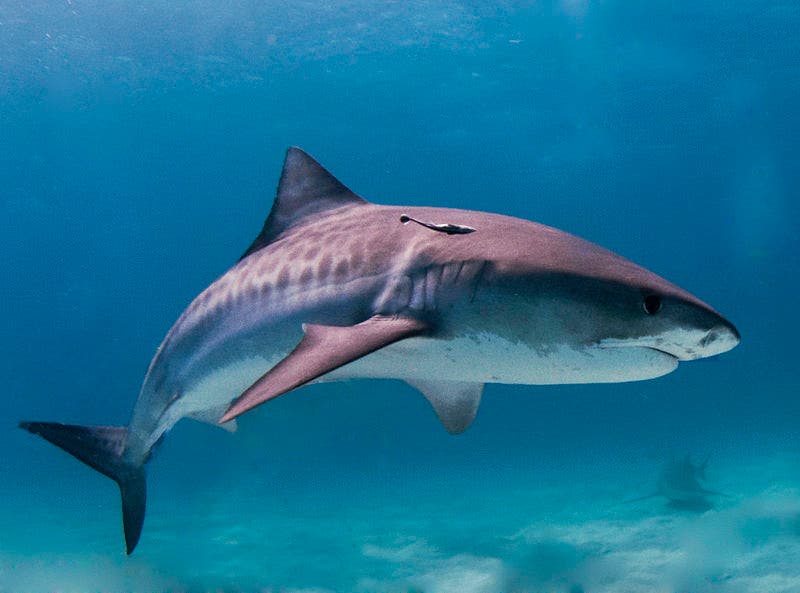
True to its name, the tiger shark is one of the sea’s fiercest and mightiest creatures. However, the name itself more so refers to the dark vertical stripes on their sides and backs that resemble the coat of feline predators.
These slow-moving sharks live all across the world in subtropical water, where they subsist on an omnivorous diet.
Tiger sharks are famous for their incredible senses of sight and smell, being able to react to even the faintest traces of blood, which makes them excellent scavengers. They’re so sensitive, it’s said they can even detect electricity.
Aside from reaching 4 meters in length (14 feet) and weight up to 635 kg (1,400 pounds), the tiger sharks can be intimidating due to their sharp and highly serrated teeth. Their jaws are so powerful they can easily crack open the shells of sea turtles and clams, although they’re known for also eating stingrays, seals, birds, squids, as well as the occasional old tires and license plates. Unfortunately, humans are also sometimes on the menu. Alongside great whites, tiger sharks have earned a reputation for attacking people.
Due to fishing for their fins, skin, flesh, and livers, tiger sharks are listed as near threatened.
Blue Shark (Prionace glauca)
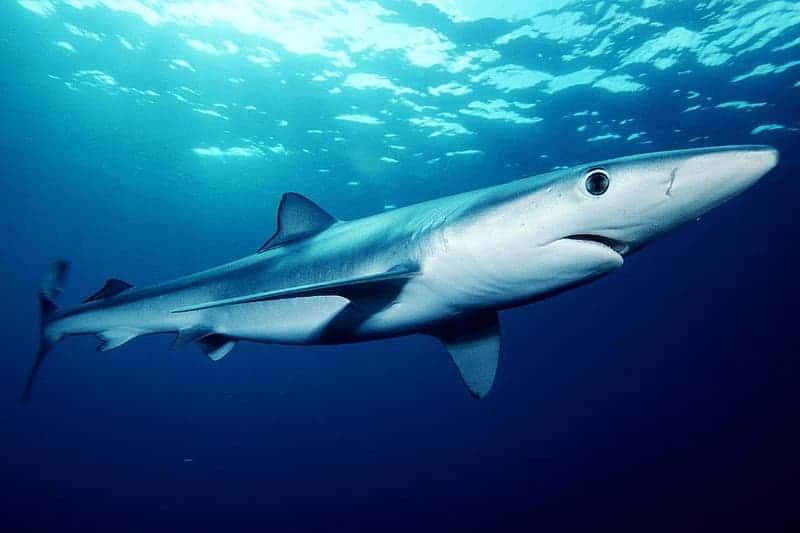
With their big eyes and small mouths, blue sharks are perhaps the cutest of them all. They get their name due to their dark blue backs and lighter blue sides. Curiously, their indigo color quickly changes to a uniform dark grey if they are pulled out of the water.
Growing up to 13 feet (4 meters) in length and weighing up to 330 pounds (150 kilograms), these curious open-ocean predators are also recognizable for their exceptionally slender bodies and elongated conical snout. Often, they are seen swimmingly slowly at the surface with the tips of their dorsal and caudal fins out of the water.
Their favorite food is squid and herring, although they’re known to occasionally munch on the carcasses of whales and turtles. No longer than 3 meters (10 feet), blue sharks are not aggressive with humans although they’re known to approach divers, being highly curious fish.
The blue shark is estimated to be the most heavily fished shark in the world, with annual global catch estimates of around 20 million individuals each year. Oddly enough, they’re not targeted for their meat or fins. Instead, they’re simply bycatch of longline and driftnet fisheries. For this reason, they are classed as ‘Near Threatened’ on the IUCN Red List.
Thresher Shark (Alopiidae)

Thresher sharks are large sharks of the family Alopiidae that are found in all temperate and tropical oceans, and whose defining feature is their weaponized tails.
There are three species of thresher shark: the common thresher (Alopias vulpinus), the bigeye thresher (Alopias superciliosus), and the pelagic thresher (Alopias pelagicus). All three species are known for their slender, streamlined bodies and long, whip-like tails, which can be as long as the rest of their body.
In the case of most sharks, it’s their front ends you should be worried about. But with threshers, you need to be careful at both ends. When attacking prey, the thresher slings the scythe-shaped tail tip over its head like a trebuchet with an astonishing top speed of 128 km/hour (80 mph).
The impact can be devastating, stunning fish or outright killing them on the spot. The shark then simply swims around and has its pick.
Growing up to 20 feet (6 meters) in length and weighing up to 1,400 pounds (635 kilograms), the thresher shark is a powerful predator that feeds on a wide variety of prey, including fish, squid, and small sharks.
This extraordinary predatory behavior, however, is very rare to spot. Threshers hunt in the open ocean and usually during the dark.
Silky Shark (Carcharhinus Falciformis)
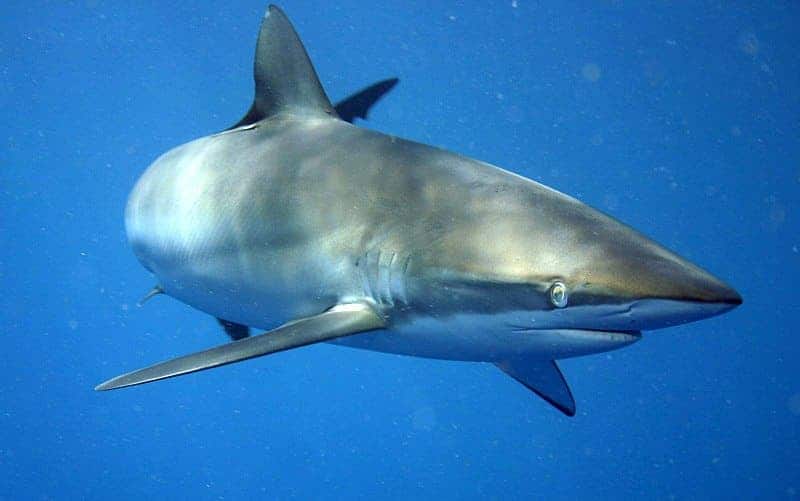
Named after its smooth skin (a result of densely packed dermal denticles), the silky shark is a highly migratory type of shark found in subtropical waters in the western Atlantic, Pacific, and Indian Oceans. It grows up to 11 feet (3.4 meters) in length and can weigh up to 220 pounds (100 kilograms).
Like the thresher, the silky shark’s pectoral fin is shaped like a sickle. Another distinctive feature of silky sharks is the shape of their teeth. On each side of their upper jaws, they have 14 to 17 teeth that are notched or serrated rather than concave.
Pacific Sleeper Shark (Somniosus pacificus)

Pacific sleeper sharks are large deep-water sharks that reach about 4.4 meters (14 feet) in length. Thought to be relatively common, sleepers are lumbering and sluggish creatures that can be found in the North Pacific from Japan to Mexico.
Their sluggish nature is also why they’ve been named sleeper sharks. They probably rarely exceed speeds over a few miles per hour (5 km/hr).
It can be found throughout the North Pacific Ocean, from the Bering Sea to the Gulf of California, and is known to migrate across entire ocean basins in search of food and suitable habitat.
Leopard Shark (Triakis semifasciata)

Leopards are among the most common type of shark off the coast of California. They’re named after their leopard-like dark spots over their silver or grey bodies, which are used for camouflage and communication with other sharks.
Leopard sharks love to swim near the ocean floor, where they spend most of their time just a foot or so above the bottom. This is because they, like all sharks, lack the swim bladders that other fish use to fine-tune their buoyancy. Instead, a leopard shark stores oil in its enormous liver to balance its weight.
It can be found along the coast of California and Mexico and is known to migrate up and down the coast in search of food and suitable habitat.
There have been no fatal attacks on humans by leopard sharks, although leopard sharks are occasionally caught in fishing nets and consumed for food. However, because of the high mercury content of its flesh, scientists warn against consuming this shark.
Lemon Shark (Negaprion brevirostris)
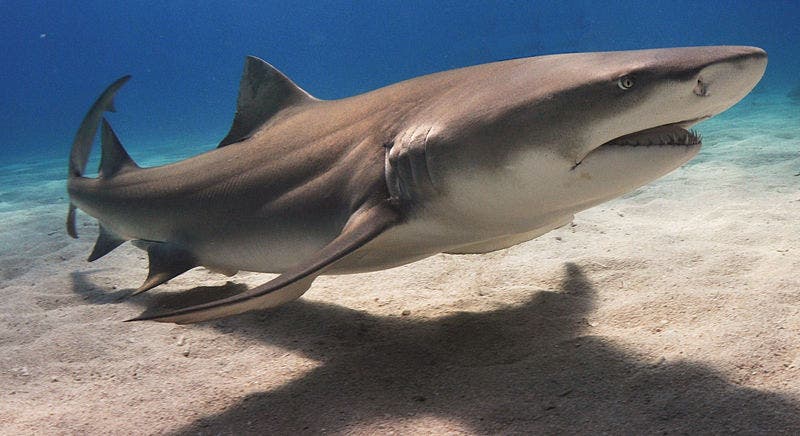
Lemon sharks are easy to spot due to their yellow-to-brown dorsal color, which helps them camouflage against the sandy seabed. These medium-sized nocturnal predators usually hunt fish cooperatively in small groups — especially when drops of blood unleash a feeding frenzy.
Growing up to 10.5 feet (3.2 meters) in length and weighing up to 350 pounds (160 kilograms), it can be found in every major ocean and is known to migrate across entire ocean basins in search of food and suitable habitat.
Although the lemon shark is an aggressive predator, they are thought to be harmless to people. If anything, the lemon shark should be worried about humans, who are responsible for the rapid destruction of mangrove coastlines that protect baby lemon sharks from larger predators. For this reason, the lemon shark is classified as ‘Near Threatened.’
Oceanic Whitetip Shark (Carcharhinus longimanus)
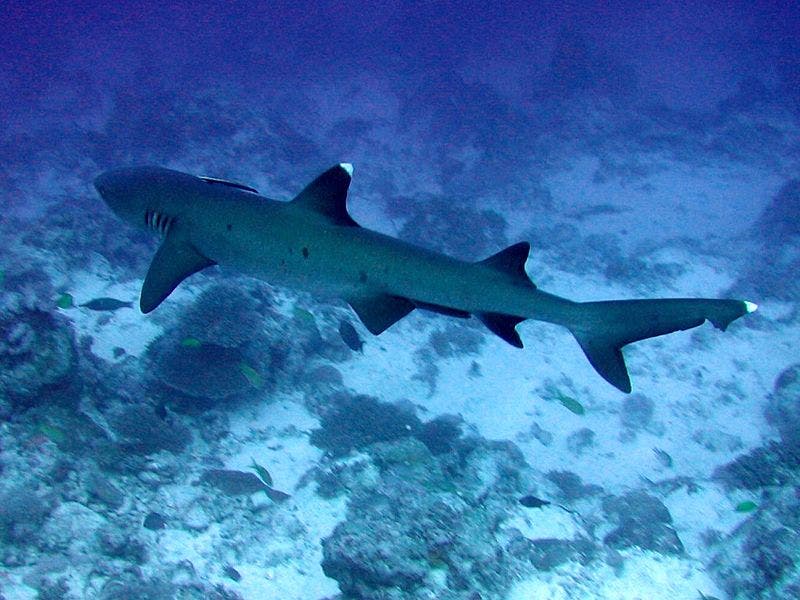
Oceanic whitetips are famous for attacking shipwrecked sailors in tropical and subtropical waters. Some of their defining features include white-tipped first dorsal, pectoral, pelvic, and tail fins. Sadly, humans took their revenge a bit to the extreme.
“We’ve absolutely annihilated the species on a global scale,” says Demian Chapman, one of the few scientists who have studied the shark. “And yet when I say ‘oceanic whitetips,’ a lot of people have no idea what I’m talking about.”
The once abundant, now elusive whitetip shark is listed as ‘Threatened’ under the Endangered Species Act.
Blacktip Reef Shark (Carcharhinus melanopterus)
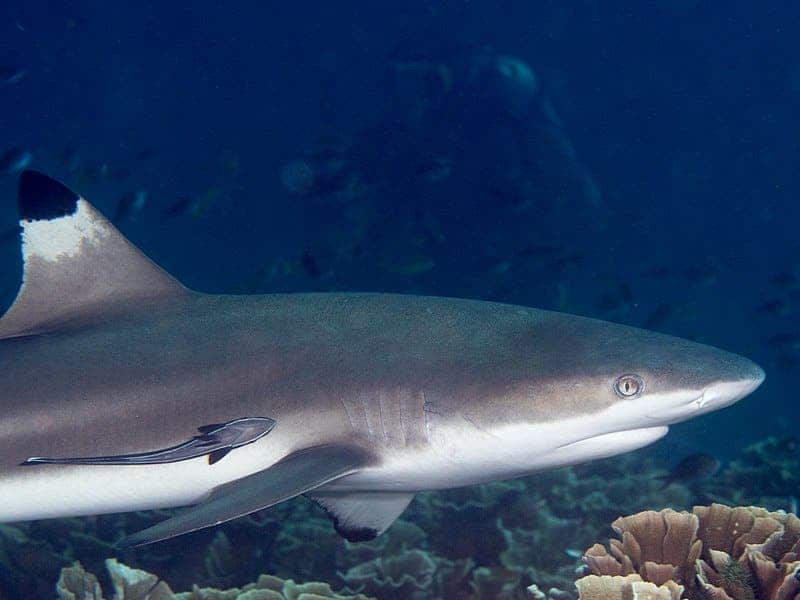
The blacktip reef shark is commonly seen in many tropical reefs, where it swims through shallow waters. It’s a small-medium-sized shark that is named for the distinctive, black tips on the tips of its fins, which are most pronounced on the pectoral fins and give the shark a distinctive, dark appearance.
Growing up to 7 feet (2.1 meters) in length and weighing up to 100 pounds (45 kilograms), the blacktip shark is a streamlined, agile predator.
Since they’re totally harmless to humans and they like to live in reefs, blacktip reef sharks are a popular species in dive tourism. They’re also frequently displayed in aquariums.
Great white Shark (Carcharodon carcharias)
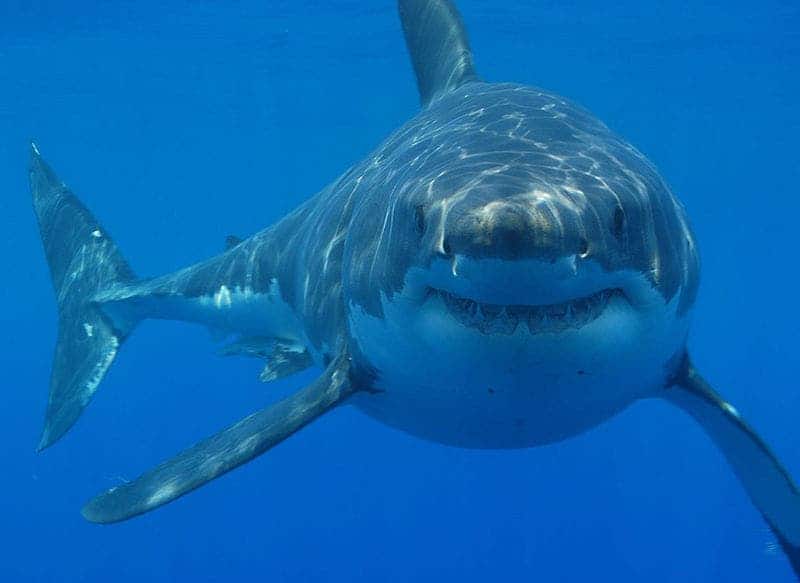
We’ve saved the best for last.
The undisputed king of the ocean needs no formal introduction. With a maximum size estimated at 6 meters (20 feet) and weighing more than 1,800 kg (4,000 pounds), the white shark is the largest predatory fish on Earth.
The white is found in cool, coastal waters around the world, where it preys on other sharks, crustaceans, mollusks, and sea birds. Its mouth is lined with up to 300 serrated, triangular teeth arranged in several rows. They are opportunistic feeders and will eat almost anything, including seals, dolphins, and even whales.
But despite its reputation as a man-eater, which was largely amplified by the cult classic movie Jaws, great white attacks are very rare. In fact, every year there aren’t more than 80 reported shark attacks — that include great whites, tiger sharks, bull sharks, and every other species of shark. As for the number of fatalities resulting from these attacks, you can count them on two hands. There are more people killed in any given year by vending machines than by sharks. Most attacks are hit-and-run in which the shark bites and then leaves, and are usually non-fatal.
There’s no reliable data on the great white population size, but scientists agree that great white shark numbers are dwindling precipitously. The species is currently classed as ‘Vulnerable ‘ — which is one step away from ‘Endangered’ — by the IUCN.
Sharks come in a variety of shapes and sizes, each with its own unique adaptations and behaviors. From the great white to the sawfish, these incredible creatures are an important part of the ocean ecosystem and deserve our respect and protection.


